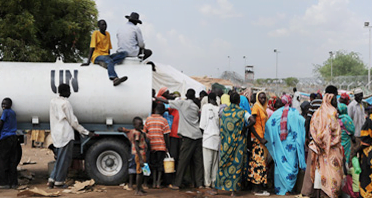Arguably the worst place in the world to be today is in the south-western borderlands between Sudan and the soon to be new country of South Sudan.
In less than a month, South Sudan will declare independence and be recognized by the international community as a full-fledged independent nation. The Sudanese government in Khartoum is not blocking this. But they are doing their best to make sure that the demographic make-up of the border region excludes tribes traditionally aligned with the South.
This is ethnic cleansing. And it is ongoing on two fronts along the border.
The first round happened about a month ago in the oil-rich and disputed border region of Abyei. It was successful. Khartoum and its allied militias drove 100,000 people from their homes in a effort to lay claim to the area before the South’s secession.
Today, the Sudanese Army is occupying the region. In the near future, the Sudanese army will leave and a new UN peacekeeping mission of Ethiopian troops will take their place. That is obviously a step forward, but the thing is the ethnic cleansing has already been accomplished. The town was sacked, homes looted and burned. I would imagine families would think twice before returning to Abyei.
The second front, in the province of South Kordofan, is very much still a massacre in progress. The Sudanese government is again creating new demographic realities on the ground by forcing the expulsion of the Nuba ethnic group, which has traditionally aligned with the Southern Sudanese. The government has bombed, sent its own armed forces on rampages, enlisted local allied militias, and even planted landmines. All told, about 75,000 people have fled the fighting in South Kordofan since June 6. It is a scene of absolute horror:
A Nuba aid worker who said he was in Kadugli at the start of fighting on June 5 described what he said was a planned campaign of ethnic cleansing. The Sudanese army and Arab militias descended on the homes of known Nuba opposition sympathizers and executed them on the spot, he said. Bloodbaths unfolded in the Kadugli streets, he said, as Nuba were shot as they attempted to flee.
An Arab militia member told him that the force had been given orders to “just clear,” the aid worker said on the condition of anonymity for fear of retaliation.
Other aid workers said women and children in SPLA-controlled areas leave their homes at night to sleep in the mountains to avoid any nighttime assault.
Heavy bombardment by Sudanese military aircraft has targeted SPLA and civilian areas in towns and the mountains, and helicopter gunships have chased fleeing Nuba, according to the aid workers’ accounts.
The sad fact about all of this is that Khartoum’s strategy will probably succeed. There is a huge demographic shift underway; hundreds of thousands of new refugees and IDPs being created likely to never return home.
This is what ethnic cleansing looks like. It is ugly. But in its own sick way, it works. Unless, that is, the cleansers are forced to pay a price for their actions. So far, though, Sudanese war criminals have been able to evade justice.
